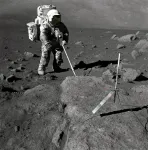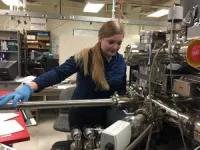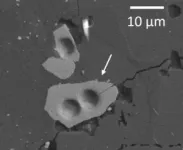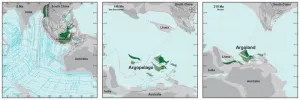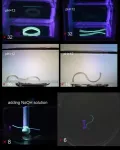(Press-News.org) More than 4 billion years ago, when the Solar System was still young and the Earth was still growing, a giant object the size of Mars crashed into the Earth. The biggest piece that broke off of the early Earth formed our Moon. But precisely when this happened has remained a mystery. In a new study in the journal Geochemical Perspectives Letters, researchers used crystals brought back from the Moon by Apollo astronauts in 1972 to help pinpoint the time of the Moon’s formation. Their discovery pushes back the age of the Moon by 40 million years, to at least 4.46 billion years old.
“These crystals are the oldest known solids that formed after the giant impact. And because we know how old these crystals are, they serve as an anchor for the lunar chronology,” says Philipp Heck, the Field Museum’s Robert A. Pritzker Curator for Meteoritics and Polar Studies and the Senior Director of the Negaunee Interactive Research Center, a professor at the University of Chicago, and the study’s senior author.
The discovery was born of Heck’s work with the study’s lead author, Jennika Greer, when she was a doctoral candidate at the Field Museum and the University of Chicago. “We were approached by our coauthors, Bidong Zhang and Audrey Bouvier, who needed a nanoscale look at these samples in order to understand them fully,” says Greer, who is now a research associate at the University of Glasgow.
The sample of lunar dust used in the study were brought back by Apollo 17 astronauts in the last crewed mission to the Moon in 1972. This dust contains tiny crystals that formed billions of years ago. These crystals are a telltale sign of when the Moon must have formed.
When the Mars-size object hit the Earth and formed the Moon, the energy of the impact melted the rock that eventually became the Moon’s surface. “When the surface was molten like that, zircon crystals couldn’t form and survive. So any crystals on the Moon’s surface must have formed after this lunar magma ocean cooled,” says Heck. “Otherwise, they would have been melted and their chemical signatures would be erased.”
Since the crystals must have formed after the magma ocean cooled, determining the age of the zircon crystals would reveal the minimum possible age of the Moon. A previous study by co-author Bidong Zhang has suggested this age, but this most recent study marks the first use of an analytical method called atom probe tomography which “nailed down” the age of this oldest known lunar crystal.
“In atom probe tomography, we start by sharpening a piece of the lunar sample into a very sharp tip, using a focused ion beam microscope, almost like a very fancy pencil sharpener,” says Greer. “Then, we use UV lasers to evaporate atoms from the surface of that tip. The atoms travel through a mass spectrometer, and how fast they move tells us how heavy they are, which in turn tells us what they're made of.”
This atom-by-atom analysis, conducted using instruments at Northwestern University, showed how many of the atoms inside the zircon crystals had undergone radioactive decay. When an atom has an unstable configuration of protons and neutrons in its nucleus, it undergoes decay, shedding some of these protons and neutrons and transforming into different elements. For instance, uranium decays into lead. Scientists have established how long it takes this process to occur, and by looking at the proportion of different uranium and lead atoms (called isotopes) present in a sample, they can tell how old it is.
“Radiometric dating works a little bit like an hourglass,” says Heck. “In an hourglass, sand flows from one glass bulb to another, with the passage of time indicated by the accumulation of sand in the lower bulb. Radiometric dating works similarly by counting the number of parent atoms and the number of daughter atoms they have transformed to. The passage of time can then be calculated because the transformation rate is known.”
The proportion of lead isotopes that the researchers found indicated that the sample was about 4.46 billion years old. Therefore, the Moon has to be at least that old.
“It’s amazing being able to have proof that the rock you’re holding is the oldest bit of the Moon we’ve found so far. It’s an anchor point for so many questions about the Earth. When you know how old something is, you can better understand what has happened to it in its history,” says Greer.
It’s important to know when the Moon formed, says Heck, because “the Moon is an important partner in our planetary system-- it stabilizes the Earth’s rotational axis, it’s the reason there are 24 hours in a day, it’s the reason we have tides. Without the Moon, life on Earth would look different. It’s a part of our natural system that we want to better understand, and our study provides a tiny puzzle piece in that whole picture.”
This study was contributed to by Jennika Greer at the University of Glasgow, B. Zhang at the University of California, Los Angeles, D. Isheim, and D.N. Seidman at Northwestern University, A. Bouvier at Bayreuth University, and Philipp Heck at the Field Museum.
###
END
(COLUMBUS, Ohio) – Necrotizing enterocolitis (NEC) is a debilitating and deadly condition that affects infants who were born preterm. In NEC cases, intestinal tissues become inflamed, and in severe cases there is ischemia and death of the involved intestines. Treatment for NEC often involves surgery to remove the dying tissue.
“Even after decades of research, little has changed in terms of prognosis for infants who develop NEC,” says Gail Besner, MD, pediatric surgeon and principal investigator in the Center for Perinatal Research at Nationwide Children’s. ...
BOSTON – In a randomized controlled clinical trial of adults with moderate-to-severe depression, those who participated in heated yoga sessions experienced significantly greater reductions in depressive symptoms compared with a control group.
The results of the trial, which was led by investigators at Massachusetts General Hospital (MGH), a founding member of Mass General Brigham (MGB), and was published in the Journal of Clinical Psychiatry, indicate that heated yoga could be a viable treatment option for patients with depression.
In the eight-week trial, 80 participants ...
Geologists have long known that around 155 million years ago, a 5000 km long piece of continent broke off western Australia and drifted away. They can see that by the ‘void’ it left behind: a basin hidden deep below the ocean known as the Argo Abyssal Plain. The underwater feature also lends its name to the newly formed continent: Argoland. The structure of the seafloor shows that this continent must have drifted off to the northwest, and must have ended up where the islands of Southeast Asia are located today. ...
Complications of diabetes can have numerous negative health effects, from impaired vision and nerve damage to kidney dysfunction and heart disease. In an analysis of information on adults with colorectal cancer, patients who also had diabetes—particularly those with diabetic complications—faced a higher risk of dying early. The results are published by Wiley online in CANCER, a peer-reviewed journal of the American Cancer Society.
For the study, Kuo‐Liong Chien, MD, PhD, of National Taiwan University, and his colleagues ...
A rise in psychological pseudoscience is putting people at risk, psychologists have warned, with social media and celebrity endorsements partly to blame.
Mental health apps, mood-boosting supplements and energy therapies are among the therapies that could do ‘more harm than good’ according to psychologists Jonathan Stea and Stephen Hupp in their new book Investigating Clinical Psychology.
“As discourse around wellness, mental health, therapy, and access to these resources increasingly enter the public domain, the potential of coming across persuasive pseudoscience has also increased,” Stea explains.
“This is the age of health misinformation. It is everywhere. ...
Do canines get more care? Some studies have suggested pet owners are less emotionally attached to and less willing to finance care for cats than dogs, possibly because of cats’ behavior: cats may be perceived as caring less about humans and needing less care in return. But these studies are often conducted on non-representative samples and don’t consider possible cultural differences in attitudes to pets. A team of scientists led by Dr Peter Sandøe of the University of Copenhagen decided to investigate further.
“We and others have found that people are willing to spend much less on their cats than ...
ROCKVILLE, Md. – Oct. 23, 2023 – The Association for Molecular Pathology (AMP), the premier global molecular diagnostic professional society, today announced the appointment of Lauren S. Menser, CAE, as its Chief Executive Officer, effective January 3, 2024. Menser will succeed Mary Steele Williams, MNA, MT(ASCP)SM, CAE, after her retirement. AMP’s national search for a new executive leader was administered by an outside consulting firm and overseen by a diverse group of member volunteers.
Menser has served AMP in various capacities for more than 17 years. Since 2016, she has served as Director of Strategic Development, ...
A large study published in CMAJ (Canadian Medical Association Journal) https://www.cmaj.ca/lookup/doi/10.1503/cmaj.230459 identified 10 predictors of opioid overdose after prescription for chronic pain, which can help clinicians engage in shared decision-making with patients around opioid prescribing.
“The opioid crisis has generated interest in identifying patients at higher risk of addiction or overdose and has led to the development of several screening tools; however, these instruments have either not been validated or shown poor psychometric properties,” writes Dr. Li Wang, a researcher and methodologist at the ...
A team of University of Waterloo researchers has created smart, advanced materials that will be the building blocks for a future generation of soft medical microrobots.
These tiny robots have the potential to conduct medical procedures, such as biopsy, and cell and tissue transport, in a minimally invasive fashion. They can move through confined and flooded environments, like the human body, and deliver delicate and light cargo, such as cells or tissues, to a target position.
The tiny soft robots are a maximum of one centimetre long and are bio-compatible and non-toxic. The robots are made of advanced hydrogel ...
The INTERLACE phase III trial, funded by Cancer Research UK and UCL Cancer Trials Centre, assessed whether a short course of induction chemotherapy (IC) prior to chemoradiation (CRT) could reduce the rate of relapse and death among patients with locally advanced cervical cancer. As part of an analysis of clinical data, the preliminary results will be presented at the European Society for Medical Oncology (ESMO) congress on Sunday 22 October 2023.
The peak incidence of cervical cancer is in women in their early thirties, with around 3,200 new cases each year in the UK. CRT has been the standard treatment for cervical cancer since 1999, but despite improvements ...
